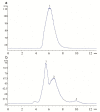Comparison of the Antioxidant Activities and Polysaccharide Characterization of Fresh and Dry Dendrobium officinale Kimura et Migo
- PMID: 36235191
- PMCID: PMC9572727
- DOI: 10.3390/molecules27196654
Comparison of the Antioxidant Activities and Polysaccharide Characterization of Fresh and Dry Dendrobium officinale Kimura et Migo
Abstract
It is generally believed that fresh Dendrobium officinale (FDO) has more significant pharmacological activity than dried Dendrobium officinale (DDO); however, the difference has not been clearly shown. Our study compared their antioxidant properties both in vitro and in vivo, and the molecular weight arrangement and monosaccharide composition of the fresh Dendrobium officinale polysaccharides (FDOPs) and the dried Dendrobium officinale polysaccharides (DDOPs) were analyzed by HPLC-GPC and GC-MS. The results showed that the FDO and its polysaccharides had more significant effects on scavenging DPPH, ABTS, and hydroxyl radicals than the DDO. In addition, both the FDO and DDO significantly reduced lipid peroxidation levels and increased the SOD, T-AOC, CAT, and GSH levels in mice with acute liver damage caused by CCl4, while the FDO and its polysaccharides were more effective. Histopathological analysis further verified the protective effect of the Dendrobium polysaccharides on CCl4-induced liver injury. The determination of the polysaccharides revealed that the polysaccharide and mannose contents of the FDO were significantly higher than their dried counterparts, and the homogeneous arrangement of the polysaccharides in the FDO was degraded into three polysaccharide fragments of different molecular weights in the DDO. Overall, our data identified differences in the antioxidant activities of the FDO and DDO, as well as the reasons for these differences.
Keywords: Dendrobium officinale; antioxidant activity; mannose; monosaccharide composition; polysaccharide.
Conflict of interest statement
The authors declare no conflict of interest.
Figures





References
-
- Oikeh E.I., Oviasogie F.E., Omoregie E.S. Quantitative phytochemical analysis and antimicrobial activities of fresh and dry ethanol extracts of Citrus sinensis (L.) Osbeck (sweet Orange) peels. Clin. Phytosci. Int. J. Phytomed. Phytother. 2020;6:1–6. doi: 10.1186/s40816-020-00193-w. - DOI
-
- Zheng Y., Lei L., Liang S., Ai J., Deng X., Li Y.-Q., Zhang T.-P., Pu S.-B., Ren Y.-S. Protective Effect of Fresh/Dry Dandelion Extracts on APAP-Overdose-Induced Acute Liver Injury. Chin. J. Integr. Med. 2021;28:683–692. - PubMed
-
- Protim M.B., Kumar B.P., Phirose K., Gitasree B., Mohan L., Saikat H. Thermolabile essential oils, aromas and flavours: Degradation pathways, effect of thermal processing and alteration of sensory quality. Food Res. Int. 2021;145:110404. - PubMed
-
- Nascimento L.D., Gomes S.S., Moraes C.M., Costa K.S.D., Baia F.P.L., Leal C.C.M., de Aguiar Andrade E.H., de Faria L.J.G. Drying Effects on Chemical Composition and Antioxidant Activity of Lippia thymoides Essential Oil, a Natural Source of Thymol. Molecules. 2021;26:2621. doi: 10.3390/molecules26092621. - DOI - PMC - PubMed
-
- Lin J.-T., Liu S.-C., Hu C.-C., Shyu Y.-S., Hsu C.-Y., Yang D.-J. Effects of roasting temperature and duration on fatty acid composition, phenolic composition, Maillard reaction degree and antioxidant attribute of almond (Prunus dulcis) kernel. Food Chem. 2016;190:520–528. doi: 10.1016/j.foodchem.2015.06.004. - DOI - PubMed
MeSH terms
Substances
Grants and funding
LinkOut - more resources
Full Text Sources
Miscellaneous

